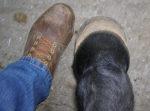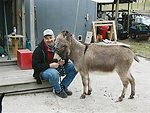Advertise Follow Us
Articles Tagged with ''Veterinarian''
The options are growing. Are you doing all you can to keep horses calm and cooperative during shoeing while keeping customers happy and yourself healthy?
Read More
Basics & Patience Can Go a Long Way
Prominent equine vet Al Kane knows first-hand that even neglected, foundered feet might respond to fundamental shoeing techniques
Read More
Inside the Perimeter: Setting The Shoe Back
Shoeing to support caudal support that doesn't have to be complicated and helps a lot of horses
Read More
You Can't Keep A Good Donkey Down
Case study of an unusual animal who seems to be thriving despite losing her coffin bone
Read More
Arming Yourself For The Battle With Laminitis
Hall Of Fame vet Ric Redden emphasizes systematic approach to dealing with this crippling malady
Read More
Open MRI Offers New Option For Diagnosing Tricky Hooves
Magnetic “collars” make this diagnostic method more practical while providing high-quality images of what’s happening inside the foot
Read More
Trim Seen As Key In Treating Stumbling, Other Conditions
Montana farrier and vet takes porportional approach to horse’s feet
Read More













